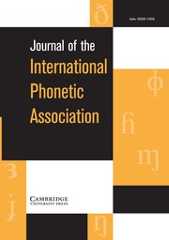Crossref Citations
This article has been cited by the following publications. This list is generated based on data provided byCrossref.
Tsukada, Kimiko 2009.An Acoustic Comparison of Vowel Length Contrasts in Standard Arabic, Japanese and Thai. p. 76.
Tsukada, Kimiko 2011.The perception of Arabic and Japanese short and long vowels by native speakers of Arabic, Japanese, and Persian. The Journal of the Acoustical Society of America, Vol. 129, Issue. 2, p. 989.
Tsukada, Kimiko 2012.Non-native Japanese listeners’ perception of vowel length contrasts in Japanese and Modern Standard Arabic (MSA). Second Language Research, Vol. 28, Issue. 2, p. 151.
TSUKADA, KIMIKO 2012.Comparison of native versus nonnative perception of vowel length contrasts in Arabic and Japanese. Applied Psycholinguistics, Vol. 33, Issue. 3, p. 501.
Tsukada, Kimiko 2013.Vowel length categorization in Arabic and Japanese: Comparison of native and non-native Japanese perception. Speech, Language and Hearing, Vol. 16, Issue. 4, p. 187.
Zaidan, Omar F. and Callison-Burch, Chris 2014.Arabic Dialect Identification. Computational Linguistics, Vol. 40, Issue. 1, p. 171.
Jadoul, Yannick Ravignani, Andrea Thompson, Bill Filippi, Piera and de Boer, Bart 2016.Seeking Temporal Predictability in Speech: Comparing Statistical Approaches on 18 World Languages. Frontiers in Human Neuroscience, Vol. 10, Issue. ,
Faris, Mona M. Best, Catherine T. and Tyler, Michael D. 2016.An examination of the different ways that non-native phones may be perceptually assimilated as uncategorized. The Journal of the Acoustical Society of America, Vol. 139, Issue. 1, p. EL1.
Redmon, Charles and Jongman, Allard 2018.Source characteristics of voiceless dorsal fricatives. The Journal of the Acoustical Society of America, Vol. 144, Issue. 1, p. 242.
Kalaldeh, Raya and Al-Shdaifat, Abd Allah 2019.The influence of emphatic /dˁ/ on Modern Standard Arabic vowels: An acoustic analysis. Lingua Posnaniensis, Vol. 61, Issue. 1, p. 43.
Elrefaie, Dina Ahmed Hegazi, Mona Abd El-Fattah El-Mahallawi, Marwa Mohammed and Khodeir, Mona Sameeh 2021.Descriptive analysis of the development of the Arabic speech sounds among typically developing colloquial Egyptian Arabic-speaking children. The Egyptian Journal of Otolaryngology, Vol. 37, Issue. 1,
Hegazi, Mona Abdel-Fattah Saad, Aya Mohammed and Khodeir, Mona Sameeh 2021.Development of a test for assessment of the lipreading ability for children in the Arabic-speaking countries. The Egyptian Journal of Otolaryngology, Vol. 37, Issue. 1,
Zuraiq, Wael and Sereno, Joan A. 2021.Second Language Speech Learning. p. 290.
Baird, Louise Evans, Nicholas and Greenhill, Simon J. 2022.Blowing in the wind: Using ‘North Wind and the Sun’ texts to sample phoneme inventories. Journal of the International Phonetic Association, Vol. 52, Issue. 3, p. 453.
Armostis, Spyros and Karyolemou, Marilena 2022.Contact-Induced Change in an Endangered Language: The Case of Cypriot Arabic. Languages, Vol. 8, Issue. 1, p. 10.
Zaltz, Yael and Segal, Osnat 2022.THE PERCEPTION OF ARABIC VOWEL DURATION BY L1 HEBREW SPEAKERS. Studies in Second Language Acquisition, Vol. 44, Issue. 1, p. 143.
Sheydaei, Iman 2024.Dearborn English: an ethnolinguistic repertoire for MENA Americans. Journal of Linguistic Geography, Vol. 12, Issue. 2, p. 124.
Turki, Houcemeddine Gibson, Maik Zribi, Rafik Adel, Imed Hadj Taieb, Mohamed Ali Ben Aouicha, Mohamed Ellouze, Kawthar Ben Ammar, Hager and Bennour, Abderrezak 2024.Tunisian: Normalized Pronunciation. SSRN Electronic Journal,
Turki, Houcemeddine Gibson, Maik Zribi, Rafik Adel, Imed Hadj Taieb, Mohamed Ali Ben Aouicha, Mohamed Ellouze, Kawthar Ben Ammar, Hager and Bennour, Abderrezak 2025.Advancements in Machine Learning and Natural Language Processing: Innovations and Applications. Vol. 1303, Issue. , p. 204.


